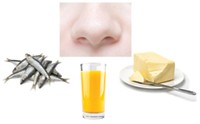Advertisement
Grab your lab coat. Let's get started
Welcome!
Welcome!
Create an account below to get 6 C&EN articles per month, receive newsletters and more - all free.
It seems this is your first time logging in online. Please enter the following information to continue.
As an ACS member you automatically get access to this site. All we need is few more details to create your reading experience.
Not you? Sign in with a different account.
Not you? Sign in with a different account.
ERROR 1
ERROR 1
ERROR 2
ERROR 2
ERROR 2
ERROR 2
ERROR 2
Password and Confirm password must match.
If you have an ACS member number, please enter it here so we can link this account to your membership. (optional)
ERROR 2
ACS values your privacy. By submitting your information, you are gaining access to C&EN and subscribing to our weekly newsletter. We use the information you provide to make your reading experience better, and we will never sell your data to third party members.
Business
Seeking Saltiness
New findings on salty taste may inspire ways to trick the tongue
by Carmen Drahl
June 1, 2009
| A version of this story appeared in
Volume 87, Issue 22

FOR THOSE WHO want sweetness without the calories, there are plenty of options available. But when it comes to imparting saltiness to food, there is pretty much one choice: sodium chloride. The food industry would like to change that.
Cutting NaCl intake in a population lowers average blood pressure and can reduce the risk of diseases such as stroke. That's why international authorities such as the World Health Organization advocate population-wide measures to lower the amount of NaCl people consume.
Prepared foods are a major target of salt-reduction efforts because they often contain more salt than anybody needs for their health. As a consequence, food companies are seeking new ways to reduce salt levels in their products while also preserving the salty taste that consumers find appealing, says Andreas Haenni, global vice president of the savory segment at Swiss flavors and fragrances company Givaudan.
Companies have been working toward that goal for years, but finding a replacement for NaCl in food isn't easy. Some say it might even be impossible. Researchers are also thinking about how to make small amounts of NaCl taste saltier, an effort that includes trying to learn more about the biology of salty taste.
"The complete molecular basis of how we detect salt is unknown," says Paul A. S. Breslin, an experimental psychologist at the Monell Chemical Senses Center, in Philadelphia, and the Department of Nutritional Sciences at Rutgers University. Two different ion-channel proteins have been implicated in salt sensing on the basis of tests in animals, he says. But even when both of those proteins are put out of commission, animals can still perceive salt, which means that the salt-sensing picture scientists have in mind is incomplete. G-protein-coupled receptors, which play a role in other taste pathways, may also be involved in sensing saltiness, Breslin says.
New pieces of salt-taste biology are still emerging. For instance, in 2008, San Diego-based flavor company Senomyx reported the discovery of what its scientists believe is the primary receptor responsible for salt-taste perception in humans. The company has not disclosed the identity of the receptor, which it has dubbed SNMX-29. Additionally, in two recent patents, the company provides evidence that a cation channel called TRPML3 is involved in salty taste perception.
Despite having an incomplete picture of how humans sense salt, several companies are forging ahead with salt-reduction research. The task isn't just about finding another compound that tastes salty. NaCl enhances food flavors, blocks bitterness, and contributes to specific tactile sensations in the mouth, Breslin says.
What's more, in many food products NaCl has a structural or stabilizing role and can also play a part in the cooking process, says F. Raymond Salemme, chief executive officer at New Jersey-based flavor company Redpoint Bio. "When people talk about a salt substitute, they're talking about something that can replace the functionality of salt," he says.
For all those reasons, it's shaping up to be nearly impossible to completely replace NaCl, Breslin says. Potassium chloride, the most common compound used in salt replacers, is a good substitute for much of NaCl's functionality. However, it also has a bitter taste that some consumers find unpleasant. Many KCl salt substitutes still contain some NaCl, which helps block the bitterness.
Several companies are developing additives for masking that bitterness. For instance, Redpoint has developed bitterness blockers that combine the sulfonic acid taurine with nucleotides such as adenosine 5'-monophosphate (AMP). They're thought to work by reducing taste-cell activation by bitter compounds while enhancing salty and umami (often described as savory) sensations.
BECAUSE IT'S TOUGH to replace NaCl, researchers are also trying to make less NaCl go a longer way by finding ways to enhance salty taste.
Amino acids are among the simplest compounds that can do that job. At the Monell Center, Breslin and his colleagues are studying the biochemistry of how the amino acid l-arginine enhances salty taste. "My guess is that arginine is affecting how long an ion channel remains open, but how it does that isn't clear," Breslin says. One way to find out might be to mutate amino acids along the channel pore in taste cells and see how that changes arginine's effects, he says.
Companies are also actively searching for new salt enhancers. Givaudan, for one, found inspiration for a salt enhancer in bonito, a fermented fish that's the basis of a broth commonly used in Japanese food, says Robert G. Eilerman, the company's senior vice president for global science and technology. The enhancer, acetyl guanosine monophosphate (GMP), is related to GMP derivatives that impart a characteristic umami sensation to the fish. Salty and umami tastes are complementary and can be manipulated to minimize deficiencies in one area or the other, Eilerman says.
Enhancing salt taste through umami taste may not be the only way to go. For instance, compounds that have a cooling effect, such as menthyl lactate, can amplify the taste of saltiness at very low concentrations, low enough that the compounds' cooling effects aren't observed, Eilerman says. Givaudan has patented a series of cooling compounds that company scientists now are optimizing for salt enhancement, he adds.
Manipulating salt's physical characteristics might be another effective way to enhance salty taste and therefore lower foods' salt content. Leatherhead Food International (LFI), a food research center in England, is taking this approach. The company has demonstrated that smaller salt crystals produced by a freeze-drying method make for a more fast-acting and therefore altered salty sensation on the tongue. "Sodium chloride must dissolve before we perceive it," and that physical process is intimately linked to the crystals' shapes and sizes, says Cindy Beeren, sensory and consumer manager at LFI.
"The complete molecular basis of how we detect salt is unknown."
Salt formulations that include emulsions might be yet another way to influence how the tongue senses saltiness, says Stuart Clegg, principal scientist in the ingredients and food innovation section of LFI. Scientists at the company have studied salty taste perception of double emulsions, wherein drops of water are encased in a larger droplet of oil that's surrounded by water. "We put salt in the inside water layer and sugar on the outside water layer, or vice versa," Clegg says. Even though the same amount of salt was added in both cases, taste testers reported that the emulsions with salt on the outside layer seemed saltier, he says.
Currently, researchers aren't looking for one salt-reduction strategy that is better than all the others and that can be applied to every food or beverage. "Our experience suggests that a one-size-fits-all salt-reduction solution is not practical at this point," Givaudan's Eilerman and Haenni told C&EN in an e-mail. Each type of food presents different challenges for taste researchers, so a range of salt-reduction strategies seems to be the approach for now, they added.
Beeren concurs, noting that LFI's emulsions would likely work best in liquids such as salad dressings, whereas small salt crystals would be best suited to sprinkling atop potato chips and other snacks.
No matter what the strategy, reducing salt content in foods is about helping people stay healthy, Breslin says. But population-wide salt-reduction efforts backed by public health data may not always translate into a benefit for every individual, Breslin cautions.
Still, as the pressure from consumers and regulatory agencies to drive down NaCl consumption grows, researchers are bound to take heed and to continue making strides in salt-reduction strategies, Breslin says. "A lot of what food science does is to give people what they want," he adds.
.






Join the conversation
Contact the reporter
Submit a Letter to the Editor for publication
Engage with us on Twitter